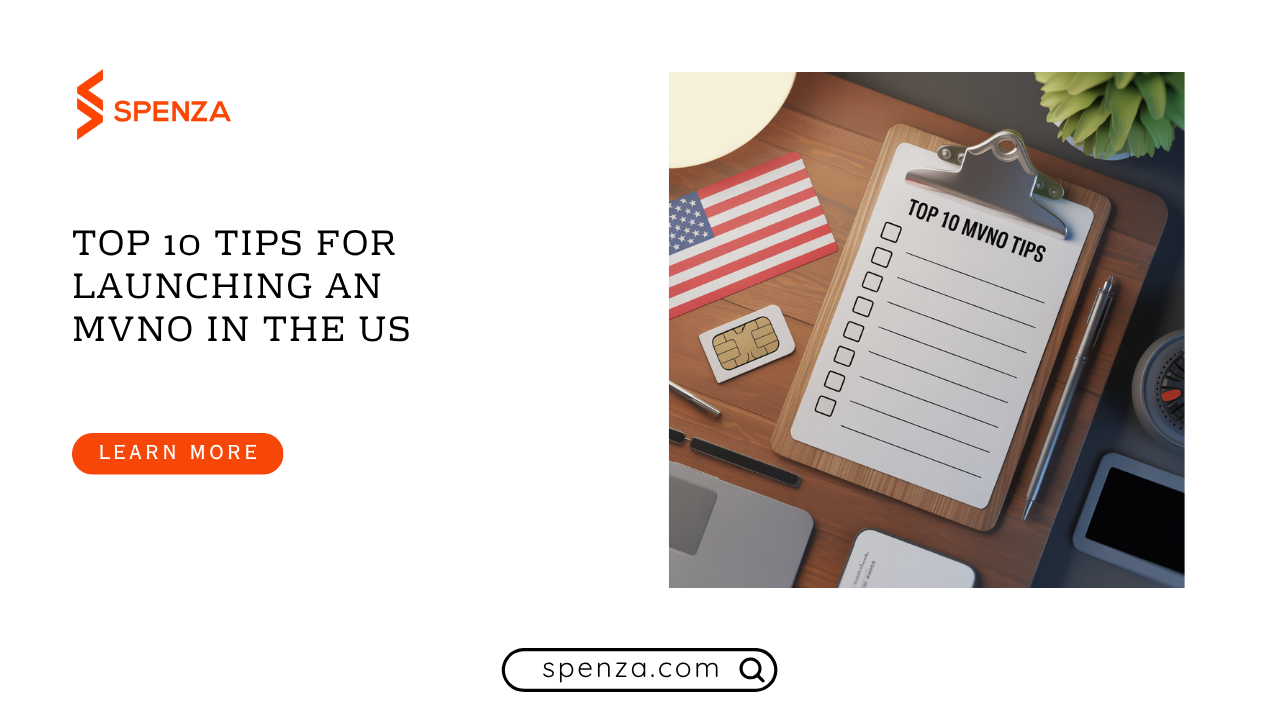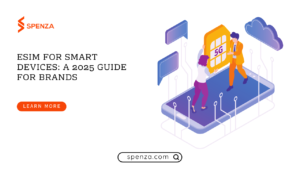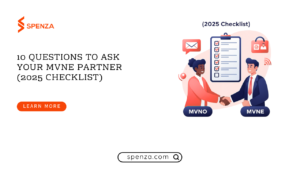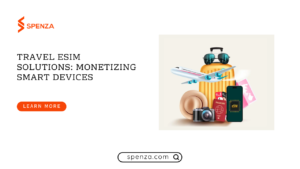TL;DR (for busy founders & product leaders)
- Niche first. Pick a segment you can own (families, travelers, IoT, creator communities), not the entire market.
- Go MVNE over Full MVNO (for speed + lower CapEx). Launch in weeks, not 12–18 months.
- eSIM-first onboarding. 100% digital activation → lower CAC, fewer ops headaches.
- Model your unit economics (LTV, CAC, ARPU, gross margin) before launch; monitor weekly.
- Compliance won’t do itself. Plan for USF/E911/CALEA/CTIA + taxes from day zero.
- Multi-carrier coverage to avoid dead zones and PR disasters.
- Obsess over CX. Ship a clean self-serve portal/app with clear SLOs.
- Engineer your first 1,000 customers with focused paid + SEO + partnerships.
- Pick a partner, not just a platform. Evaluate roadmap, support, and economics.
- Spenza: All in one MVNE, compliance, billing, eSIM orchestration, marketplace, Shopify app and more.
Definition, in one line: An MVNO (mobile virtual network operator) sells mobile service over existing MNO networks without owning the radio access network; in the US, most new MVNOs launch via an MVNE to reduce time-to-market and upfront cost.

Introduction: Why your MVNO idea is viable in 2025
US consumers are migrating toward specialized, digital-first mobile brands: traveler-friendly data, family safety bundles, creator perks, and low-bandwidth IoT connectivity. The building blocks—5G, eSIM, cloud OSS/BSS, AI-driven care—make it feasible to launch and scale with modest capital if you execute a focused playbook and partner well.
What Will You Gain from This Article?
- Get a clear, actionable plan to launch your own mobile service in 2025.
- Learn how to find a profitable niche and avoid common, costly mistakes.
- Discover the fastest, lowest-risk path to market with a strategic partner.
- Understand how to use modern tech like eSIM to build a successful brand.
Our Top 10 Tips for a Successful 2025 MVNO Launch
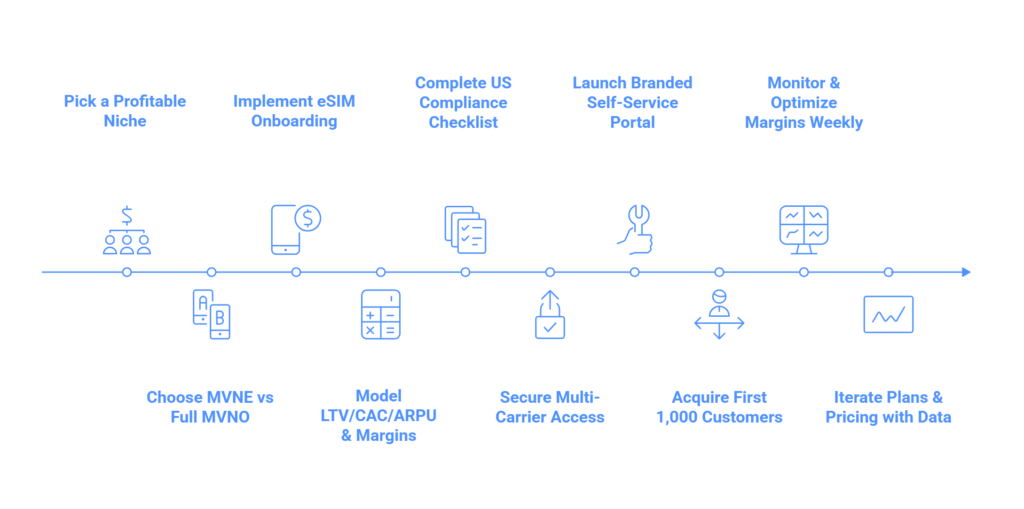
Tip 1 — Niche down to stand out
Action: Define a tightly-scoped segment with a clear “why us.”
Why it matters: Competing on generic price vs national carriers is a losing game.
How to do it: Validate 2–3 segments (search trends, CAC benchmarks, community partners). Build plan features and support flows for that niche.
Examples of viable niches
- Connected devices (IoT): wearables, trackers, CCTV—often low data, high reliability.
- International travelers & expats: roaming-friendly eSIM packs, local numbers.
- Families & seniors: safety features, content controls, simple billing.
Mini Case Study: Speciality Connectivity for IoT
Consider a company like Butlr, which develops IoT sensors for home automation. Their devices require reliable, high-bandwidth mobile plans across multiple countries, including the US, UK, France, and Germany. A traditional MNO would require separate, complex, and expensive negotiations for each region.
By partnering with Spenza’s platform, Butlr can procure custom plans for all its markets, manage all services, and pay a single bill through one unified dashboard, dramatically simplifying its operations and enabling faster global expansion.
Tip 2 — Choose the right path: MVNE over Full MVNO (for most)
Action: Start on an MVNE unless you have deep telco ops and $MM budget.
Why it matters: Faster launch, lower risk, fewer moving parts.
How to do it: Compare partners on (a) coverage options, (b) eSIM orchestration, (c) billing & tax, (d) regulatory support, (e) analytics, (f) TCO & margins.
The strategic shortcut is to partner with a Mobile Virtual Network Enabler (MVNE). An MVNE like Spenza provides the entire end-to-end technology platform as a service or TaaS. This includes the network integrations, billing systems, customer management portals, and regulatory compliance tools.
This approach transforms your business model from one requiring massive upfront capital investment (CapEx) to a manageable, pay-as-you-go operational expense (OpEx) model.
| Factor | Full MVNO (Direct to Carrier) | MVNE Partnership |
|---|---|---|
| Time-to-Market | 12 – 18 Months | Weeks or even Days |
| Upfront Cost (CapEx) | $1M – $5M+ | < $10,000 (often much less) |
| Operational Complexity | Extremely High (Requires large, specialized team) | Low (Handled by the MVNE partner) |
| Best For | Massive, well-funded enterprises with deep telecom expertise. | Startups & businesses seeking speed, low risk, and focus on brand/marketing. |
Bottom line: If your near-term goal is brand, distribution, and product-market fit, MVNE wins.
Tip 3 — Embrace eSIM from day one
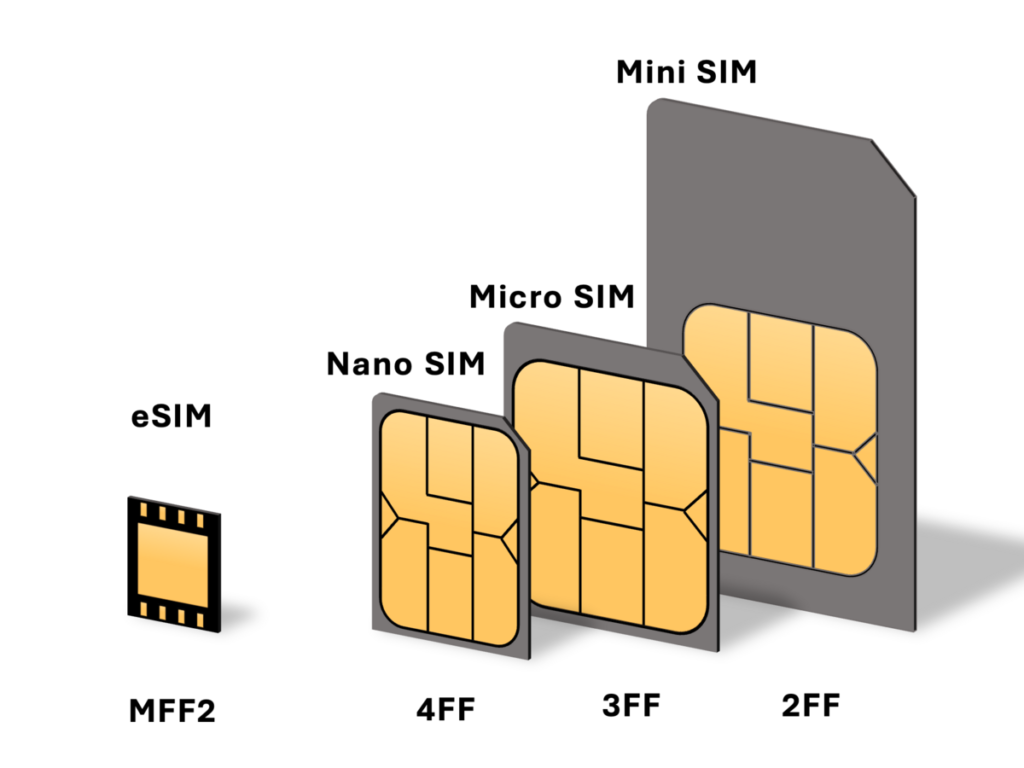
Action: Make activation 100% digital with eSIM.
Why it matters: Frictionless onboarding → higher conversions, lower logistics cost.
How to do it: Offer QR-based activation, device checks, instant plan swaps, and family sharing. Keep a limited physical SIM fallback where needed.
Tip 4 — Master your unit economics
Action: Lock in a margin model before launch and monitor weekly.
Why it matters: Sustainable growth = LTV > CAC with healthy gross margin.
How to do it: Track ARPU, wholesale costs (voice/SMS/data), payment fees, CX costs, and churn. Set guardrails (e.g., pause promos if gross margin < X%).
Pocket formula
Per-subscriber gross margin = ARPU − (Carrier wholesale + Platform + Care + Payment fees)
Payback = CAC ÷ (Gross margin per month)
Calculate your MVNO launch costs using our free MVNO calculator.
Tip 5 — Don’t get derailed by the regulatory maze
Action: Build a compliance checklist and calendar.
Why it matters: Missed filings or gaps (USF, E911, CALEA, STIR/SHAKEN for voice, CTIA guidelines, state taxes/Nexus) can cause fines or service issues.
How to do it: Use MVNE templates for registrations, 911 address collection, lawful intercept readiness, and tax automation. Document policies & audit trails.
Pro Tip: Spenza acts as your regulatory shield. Our platform is built to be compliant, and our expert team manages the intricate registration and reporting requirements on your behalf, allowing you to scale with confidence.
Tip 6 — Build a brand, not just a business
Action: Ship a distinctive story, not only a price point.
Why it matters: A memorable brand lowers CAC and improves retention.
How to do it: Clear positioning, tone, visuals, referral loop, and community. Align every touchpoint (site, app, emails, care scripts) to the promise.
Tip 7 — Don’t put all your eggs in one network basket
Action: Offer multi-carrier coverage.
Why it matters: Coverage varies by region; single-carrier bets risk bad reviews/churn.
How to do it: Use multi-IMSI/eSIM profiles and policies to prefer the best signal or best economics.
Mini Case Study: The Power of Multi-Carrier Support
Angel Watch, a company providing smartwatches for children, resells mobile plans in both the US and the UK. For their product, reliability isn’t just a feature—it’s a promise of safety and peace of mind for parents.
By leveraging Spenza’s multi-carrier relationships, Angel Watch can ensure their devices have reliable connectivity across different regions, and they can manage all their subscribers through one platform, even when they are on different underlying networks.
Tip 8 — Obsess over the customer experience (CX)
Action: Publish CX SLOs and meet them.
Why it matters: Onboarding or support friction kills word-of-mouth.
How to do it: Branded self-serve portal/app, instant plan changes, pro-rated billing clarity, real-time usage, smart alerts, and human escalation when needed.
Suggested SLOs
- Activation success rate ≥ 98%
- First response time: < 2 hours (email), < 5 minutes (chat during business hours)
- Same-day resolution rate: ≥ 85%
Tip 9 — Engineer your first 1,000 customers
Action: Run a focused GTM sprint.
Why it matters: Early traction validates pricing, CX, and coverage.
How to do it: 60–90 day plan: 1) Paid acquisition (search + social with niche hooks), 2) SEO content (answer intent-rich queries), 3) Partnerships (affiliates, community leaders, device makers), 4) Referral program from day 1.
Tip 10 — Choose a partner, not just a platform
Action: Evaluate partners with a scorecard.
Why it matters: You’re tying your brand to their capabilities and roadmap.
How to do it: Weigh coverage, eSIM orchestration, billing, compliance support, analytics, SLA, pricing transparency, roadmap fit, and references.
The Spenza Advantage: Your All-in-One MVNO Launchpad
Launching an MVNO can seem daunting, but Spenza was built to turn this complex process into a simple, streamlined path to market. We embody the principles of a true strategic partner, providing not just a platform, but an entire ecosystem for your success.
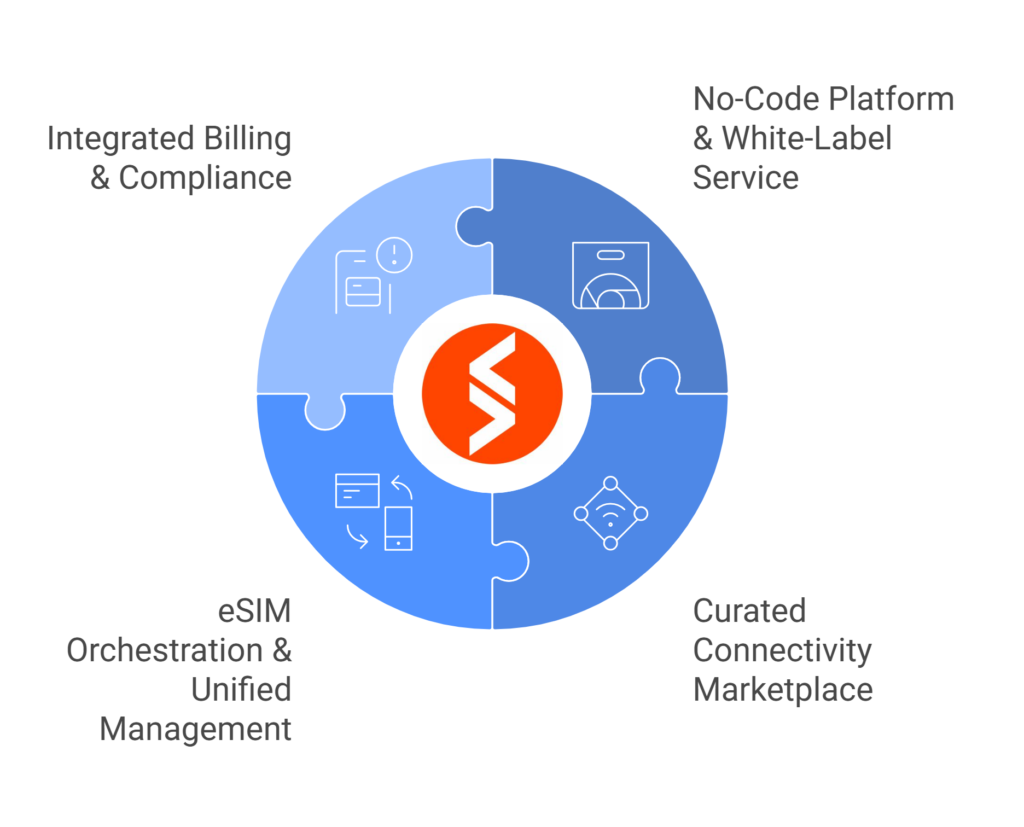
- No-Code Platform & White-Label Service: Our experts provide end-to-end guidance, from discovery to deployment. With our pre-integrated no-code MVNE and Shopify app, you can create a fully branded online store and launch in as little as 7 days, not months.
- Curated Connectivity Marketplace: Forget lengthy and expensive contract negotiations. Instantly access and resell a range of “fit-for-purpose” connectivity plans from multiple operators, ensuring you have the perfect offering for your niche from day one.
- eSIM Orchestration & Unified Management: Avoid SIM fragmentation and logistical nightmares. Manage your entire operation—ordering, activating, and managing eSIMs for all your customers—from a single pane of glass.
- Integrated Billing & Compliance: We handle the boring, complex, but critical stuff. Our platform automates billing, payments, and tax remittance. We help you stay compliant with global tax and telecom regulations so you can scale with confidence and avoid the risk of fines or shutdowns.
Conclusion: Your MVNO Launch is Closer Than You Think
While launching an MVNO in the competitive US market requires careful planning and a clear strategy, the path forward has never been more accessible. The age of insurmountable technical and financial barriers is over.
By focusing intensely on a specific niche, building a brand that resonates, leveraging modern technology like eSIM, and—most importantly—choosing a strategic partner instead of just a platform, your success is well within reach. With these tips as your guide, your vision for a unique mobile service isn’t a distant dream; it’s an achievable goal for 2025.
Ready to move? Let’s turn this checklist into a launch plan.
FAQs
It varies by scope and channels. A Full MVNO path often requires significant CapEx. An MVNE-led launch shifts most spend to OpEx and can be a small fraction of that. Your exact cost depends on branding, coverage options, support model, and integrations. To learn more check out our blog.
Often a week instead of 12–18 months—timeline depends on plan catalog, branding, compliance readiness, and any custom integrations.
Yes. Use a white‑label portal/app like Spenza, so every touchpoint reflects your brand.
Yes, Spenza’s 7-day blueprint is a proven process. Because we have pre-integrated the networks, compliance, and billing, the launch process is focused on branding and configuration, which can be completed in one week.
We offer Compliance-as-a-Service. Spenza’s platform has pre-integrated solutions for telecom tax obligations and helps you navigate regulatory requirements like reseller rights, significantly reducing your risk and administrative burden.
No. That’s the point of partnering with an MVNE like Spenza—they bring network, compliance, and billing expertise so you can focus on brand, product, and go‑to‑market.
Stop waiting. Start launching. Schedule a free demo today and we’ll build your personalized 7-day launch blueprint with you.
